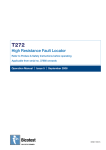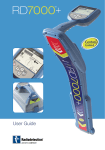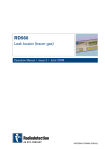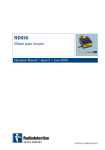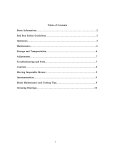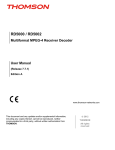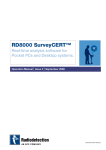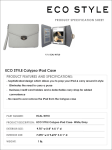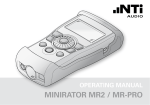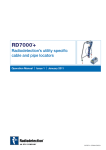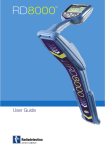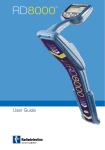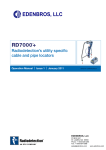Download Centros™ Manager
Transcript
Centros™ Manager Application for managing Radiodetection’s locators and transmitters Operation Manual l Issue 7 l November 2010 For use with Centros Manager 6 or later. 90/UG081ENG/07 Preface Before you begin Copyright Statement Please read this user manual before installing Centros™ Manager and attempting to use the facilities within Centros Manager. Copyright 2010 Radiodetection Ltd – SPX Corporation. All rights reserved. Note that this manual and all its contents are subject to change. Radiodetection products are under continuous development. Radiodetection Limited reserves the right to modify the product without notice and some product changes may have taken place after this user manual was published. Contact your local Radiodetection dealer or visit www.radiodetection.com for the latest product information, including this manual and the bundled software. Important Notice Radiodetection makes every effort to ensure that all technical information, statements and recommendations about its products are based on information believed to be reliable, but the accuracy or completeness thereof is not guaranteed. In no event shall Radiodetection be liable for any loss, inconvenience, damage or problems caused through use of any equipment or software. Before using any Radiodetection product (including eCAL™), the user should determine the suitability of the product for its intended use. The user assumes all risks and liability whatsoever in connection with such use. Use of eCAL™ software is bound by license agreement, a copy of which is included in the eCAL download bundle. ii Centros Manager Operation Manual Radiodetection is a subsidiary of SPX Corporation. SPX and Radiodetection are trademarks of Radiodetection Ltd. and SPX Corporation. Due to a policy of continued development, we reserve the right to alter or amend any published specification without notice. This document is protected by copyright and may not be copied, reproduced, transmitted, modified or used, in whole or in part, without the prior written consent of Radiodetection Ltd. Trademarks RD8000, RD7000, RD7000+, RD5000, Centros, eCAL and SurveyCERT are trademarks owned by Radiodetection Ltd, all rights reserved. Windows and Windows Vista are registered trademarks of Microsoft Corporation, all rights reserved. Apple and Mac are registered trademarks of Apple Inc., registered in the U.S. and other countries, all rights reserved. Atmel is a registered trademark of Atmel Corporation, all rights reserved. Table of Contents Preface ii Section 4 – Transmitter software update 6 Before you begin ii Transmitter Software Update window 6 Important Notice ii Updating your Transmitter Software 6 Copyright Statement ii Trademarks ii Section 5 – Locator eCAL validation 7 5.1 Purchasing Validation keys 7 Section 1 – Introduction to Centros Manager 1 5.2 Validating a locator 7 1.1 About Centros Manager 1 5.3 Retrieving original factory calibration 8 Software Update 1 5.4 Printing certificates 8 eCAL 1 5.5 eCAL Failures 8 Option Editor 1 Section 6 – Option Editor 9 6.1 Uploading your locator configuration 9 6.2 Downloading a configuration to your locator 9 1.2 System requirements 1 1.3 Before you begin 1 Section 2 – Installing Centros Manager 2 6.3 Saving your configuration settings 10 2.1 Installing with Windows 2 6.4 Loading your saved configuration settings 10 2.2 Upgrading Centros Manager 2 6.5 Managing your configuration settings 10 2.3 Using Centros Manager 2 Locator Software Update 2 Section 7 – Appendix 11 Transmitter Software Update 3 7.1 Administrator 11 Locator Option Editor 3 7.2 USB Tips & Tricks 11 Locator eCAL Validation 3 7.3 Update USB Driver 11 Setup 3 Setup options 3 User Messages window 4 Section 3 – Locator software update Update USB Driver for Windows XP 11 Update USB Driver for Windows Vista 14 Update USB Driver for Windows 7 16 7.4 Installation Folders 18 5 Locator Software Update window 5 Upgrading your Locator Software 5 Centros Manager Operation Manual iii Section 1 – Introduction to Centros™ Manager Centros™ Manager is a Radiodetection product support application for Microsoft® Windows that can be downloaded via the Radiodetection website. Once installed onto your PC or laptop, Centros Manager can be used for the following: • Updating the locators and transmitters with the latest software. • Validating the locator with the original factory calibration using eCAL™. This feature provides the user with the ability to validate the original factory calibration of a locator. eCAL provides the user with the confidence that the locator continues to meet its factory calibration and is safe to operate. Option Editor This utility allows you to customize your locator quickly using your PC. User configurations can be saved and recalled using this facility. A configuration can be uploaded from a unit or downloaded to it. 1.2 System requirements Microsoft® Windows XP Professional (32 bit) with Service Pack 3. Microsoft® Windows Vista (32 bit) with Service Pack 1. Microsoft® Windows 7 (32 bit) with Service Pack 1. • Customizing the settings of the locator using Option Editor. Please Note that Centros Manager does not currently support any 64 bit operating system at this time. Centros Manager can now be used with the following product set: To find out the bit count of your Operating System on Windows 7: Click Start > Settings > Control Panel > System and Security > System and then locate System Type on the General tab. • • • • • • • RD5000 RD7000 RD7000+ RD8000 TX-1 TX-3 TX-10 NOTE: Not all Centros features will be available for every product. 1.1 About Centros Manager Software Update This utility allows the user to update the software of locators and transmitters. Software updates are available to users who have registered for Radiodetection’s extended warranty program. eCAL eCAL allows the user to check that a locator is within its original factory calibration. eCAL issues a pass or fail certificate, which can be printed. eCAL can also be used to retrieve and print the original calibration certificate. To carry out eCAL the user must purchase an eCAL validation key and register for extended warranty. For more information on how to purchase a key go to section 5. For all other Windows operating systems, follow the instructions at the following link: http://support.microsoft.com/kb/827218 An active Internet connection is required to download Centros Manager and receive software update notification from Radiodetection. 1.3 Before you begin Once Centros Manager is installed, in order to download the latest software, the user will need to register each locator and transmitter for the extended warranty* program. Upon registration, the user will receive an email confirming warranty registration and also a unique electronic key, which will be required for downloading new software for both the locator and transmitter. Once registered, Radiodetection will email you when there is a new version of software available for either the locator or transmitter. *Registration is free and entitles you to free software updates. If you register within 3 months of purchase you will receive an extra 2 years warranty on both the locator and transmitter free of charge. To register your locator or transmitter please go to www.radiodetection.com/extendedwarranty NOTE: eCAL is not applicable to the transmitter. Centros Manager Operation Manual Section 2 – Installing Centros Manager 2.1 Installing with Windows When you install Centros Manager onto a PC, the following message may be displayed: “You need to log in as Administrator”. If this message is displayed, the installation of the program will not complete. You will need to log on as an Administrator or ask a user with Administration Rights to install the program on your behalf. Having successfully installed Centros Manager, the Administrator will need to carry out the instructions in Section 7.1 if they wish users without Administrator Rights to use Centros Manager. 2.3 Using Centros Manager Once you have installed Centros Manager on your computer, take a few moments to familiarize yourself with the program before you attempt to update your software, edit your locator configuration, or use eCAL. When you open Centros Manager the main Centros Manager window will open. 1. Centros Manager can be installed using the link from: www.radiodetection.com/centrosmanager 2. When you click on the link to download Centros Manager a File Download Window will appear and you will have a choice of either Run or Save. It is recommended to install Centros Manager using the Run option. The Save option can be used if you wish to download the executable file and make copies to transfer onto other PC’s or Laptops. 3. Run: Centros Manager will automatically install. 4. Save: you will be given the option to save Centros Manager to a destination of your choice. Once you select the destination, the Centros Manager executable program will download to that destination. Once completed you will have the option to Run or Open Folder. At this stage Centros Manager has not been installed so you can either select Run and Centros Manager will automatically install or you can choose to Open Folder. When you open the folder the Centros Manager executable file will be available. To install double click on this file. 5. Once Centros Manager is installed run from the Windows Start menu under Programs. 2.2 Upgrading Centros Manager When Radiodetection releases a new version of software for its locators and transmitters, the new version of software will be contained within a new version of Centros Manager. All users that have registered for Radiodetection’s extended warranty program will automatically receive an email advising them that a new version of Centros Manager is available. You can download the new Centros Manager Application bundle from: www.radiodetection.com/centrosmanager Centros Manager Operation Manual The four selectable options are as follows: Locator Software Update Allows you to update your locator with the latest software. Transmitter Software Update Setup Allows you to update your transmitter with the latest software. By highlighting File in the toolbar of each window a drop down menu will appear. Click on Setup and you will be given the opportunity to change the date format that will appear on the eCAL pass or fail certificate. Setup options Date Format: Select UK (dd/mm/yyyy) or USA (mm/dd/yyyy) date format. Overlay: Hides software files in the locator and transmitter download windows with a picture of the locator or transmitter. Locator Option Editor Allows you to change the configuration of your locator. Software Updates: Select Full to always update the software in your locator/ transmitter or Incremental to only update the software if a newer version is available. By clicking on More >> a window will appear displaying the various paths for the folders created when installing Centros Manager. The information is listed under 4 tabs; Products, User, Updates and Miscellaneous. Under the Products Tab: • RD5000 Folder: Tells Centros Manager where to locate the software for the RD5000 locator. • RD7000 Folder: Tells Centros Manager where to locate the software for the RD7000 locator. • RD7000+ Folder: Tells Centros Manager where to locate the software for the RD7000+ locator. • RD8000 Folder: Tells Centros Manager where to locate the software for the RD8000 locator. • TX-1 Folder: Tells Centros Manager where to locate the software for the TX-1 transmitter. Locator eCAL Validation Allows you to validate and verify if the locator is within its original factory calibration. • TX-3 Folder: Tells Centros Manager where to locate the software for the TX-3 transmitter. • TX-10 Folder: Tells Centros Manager where to locate the software for the TX-10 transmitter. Under the User Tab: • Validation File: Sets the location of the validation file. This file contains the validation keys the user has loaded into the application and the details of all calibration certificates created. • Download File: Sets the location of the download file. This file contains the download keys the user has loaded into the application. • Menu Settings File: Sets the location of the menu settings file. This file contains the saved settings from the configuration editor. Centros Manager Operation Manual Under the Updates Tab: • Frequency: Allows the user to determine how often they wish to check for updates of Centros Manager and Locator/Transmitter software. Centros Manager will automatically check for updates when it is run, depending on this value. This will require a ‘live’ Internet connection. • Products: Allows the user to specify which products they wish to receive notification of updates for. Under the Miscellaneous Tab: • Message Help File: Set the location of the message window HTML help file. • Centros Operation Manual: Sets the location of the Centros Manager Operation Manual. • License Agreement: Sets the location of the Centros Manager end user license agreement. User Messages window The message window appears in the lower half of each window and will display Centros system messages. It can also be used as a simple text editor and is useful for diagnosing problems and referring messages to Radiodetection Technical Support. 1 2 3 4 5 6 7 8 9 10 11 12 Message toolbar 1. New (Clear Message Window Contents). 2. Open .txt file in message window. 3. Save message window contents to .txt file. 4. Cut selected area to clipboard. 5. Copy selected area to clipboard. 6. Paste clipboard contents to message window. 7. Select all text in the window. 8. Undo the last change. 9. Redo the last undone change. 10. Insert Timestamp. 11. Turn Word-Wrap on or off 12. Email message window contents to Radiodetection 13. Open help on message window. Centros Manager Operation Manual 13 Section 3 – Locator software update From time to time, Radiodetection will release new software for their locators to enhance features and improve performance. All the latest software updates are supplied within Centros Manager. To obtain the latest Centros Manager refer to section 2. You can check the latest version of Centros Manager by visiting the Radiodetection website at: www.radiodetection.com/centrosmanager 1. Make sure you have your electronic update key before continuing. 2. Connect your locator to your computer using the supplied USB cable. On the locator, the USB port is located inside the battery compartment. 3. Open Centros Manager – Start > Programs > Centros Manager and select Locator Software Update. 4. Click the Load Software Update Key icon on the tool bar. NOTE: You must have an update key before you can update your locator’s software. Radiodetection will automatically issue you with an update key when you register for extended warranty. To register go to: www.radiodetection.com/extendedwarranty 5. Copy and paste your electronic update key into the Update Key dialog box. This is the key that you received in your confirmation email when registering your product and is similar to this: 45520-4753760028-18163-24316-20007-02791-11890. Locator Software Update window 7. Switch on the locator. At this stage the screen on the locator will be blank with the backlight switched on. Click on the Download Software icon and the latest software will now automatically install into your locator. You can view the progress of the installation in the Users Message window. The download will take approximately 5 minutes to complete. 1 2 3 4 Locator update toolbar 1. Home Page: Will take you back to the Centros Manager Home Page. 2. Download Locator Software. 3. Stop Locator Download. 4. Load Software Update Key. Upgrading your Locator Software WARNING! Interrupting the software update process may cause your locator to become inoperable. Do not disconnect the locator from the computer until the process is complete. If you are using a laptop computer make sure your laptop is sufficiently charged for the duration of the transfer. You may find that your laptop cannot supply sufficient power for the locator, if this is the case you are advised to load Centros Manager onto a desktop PC. 6. Click Add then Exit. NOTE: You may experience a problem with the USB recognizing the locator. Refer to Section 7 for more help and information. WARNING! In some circumstances, software updates may overwrite the user settings on the locator such as Power Frequency (50Hz/60Hz), StrikeAlert™ (Enable/ Disable) and Units (metric/imperial). Please update your user settings after any software update prior to using your locator. 8. Once the transfer is complete, disconnect the locator from your computer and close the battery compartment. When you switch on the locator you can check that the latest software has been downloaded. On switch on the locator model type will appear in the bottom left of the screen followed by a 4-digit number. This number should correspond to the 4-digit number in brackets, at the top of the Locator Software Update Window. Centros Manager Operation Manual Section 4 – Transmitter software update From time to time, Radiodetection will release new software for their transmitters to enhance features and improve performance. All latest software updates are supplied within Centros Manager. To obtain the latest Centros Manager refer to section 2. You can check the latest version of Centros Manager by visiting the Radiodetection website at: www.radiodetection.com NOTE: You must have an update key before you can update your transmitter’s software. Radiodetection will automatically issue you with an update key when you register for extended warranty. To register go to: www.radiodetection.com/extendedwarranty Transmitter Software Update window 3. Note: The USB connection on the PC or laptop will not supply the required power to switch on the transmitter. Users can purchase a suitable power supply from Radiodetection. Alternatively with the USB cable connected to the transmitter, place the transmitter on a flat surface without fully securing the battery pack. In this orientation the pogo pins inside the battery compartment will make contact with the battery contacts to enable powering of the transmitter. 4. Open Centros Manager – Start > Programs > Centros Manager and select Transmitter Software Update. 5. Click the Load Software Update Key icon on the tool bar. 6. Copy and paste your update key from your warranty registration email into the Update Key dialog box. This is the key that you received in your confirmation email when registering your product and is similar to this: 45520-47537-60028-18163-24316-2000702791-11890. 7. Click Add then Exit. 1 2 3 4 Tx update toolbar 1. Home Page: Will take you back to the Centros Manager Home Page. 2. Download Transmitter Software. 3. Stop Transmitter Download. 4. Load Software Update Key. Updating your Transmitter Software 1. Make sure you have your electronic update key before continuing. 2. Connect your transmitter to your computer using the supplied USB cable. On the transmitter, the USB port is located under the battery compartment. Centros Manager Operation Manual 8. Switch on the transmitter, at this stage the display on the transmitter will be blank. Click on the Download Transmitter Software icon and the latest software will now automatically install into your transmitter. You can view the progress of the installation in the Users Message window. Note: In the unlikely event that you experience a problem with the USB recognising the transmitter, please refer to Section 7 for more help and information. 9. Once the transfer is complete, disconnect the transmitter from your computer and reinstall the battery pack. When you switch on the transmitter you can check that the latest software has been downloaded. On switch on the transmitter model type will appear in the bottom left of the screen followed by a 4-digit number. This number should correspond to the 4-digit number in brackets, at the top of the Transmitter Software Update Window. Section 5 – Locator eCAL validation eCAL is part of the Centros Manager application and is a utility that validates a locator against its original factory calibration. Once validated, eCAL will issue a certificate with a pass or fail statement, which you can print. NOTE: Before you can validate the calibration of a locator you must carry out the following: 1. Download the latest version of Centros Manager, if not already done so and download the latest version of software to the locator. 2. Purchase an eCAL validation key which may be purchased by going to: www.radiodetection.com/eCAL 3. Register your product for a free extended warranty by going to: www.radiodetection.com/extendedwarranty NOTE: If you are using a laptop computer, make sure your laptop is sufficiently charged or you may find your laptop cannot supply sufficient power for the locator. If this is the case you are advised to load Centros Manager onto a desk top PC. NOTE: eCAL checks the calibration of the instrument by applying a known magnetic field to the antennas. The antennas will still be receiving external signals, so the eCAL results may be affected by external interference or the proximity of metal objects. 2. Run eCAL validation. 3. Get Original Factory Calibration Data. 4. Stop Validation. 5. Load eCAL Key. 6. Print Certificate – print the currently displayed certificate. 7. Expand Tree. 8. Collapse Tree. 5.1 Purchasing Validation keys Once you have purchased an eCAL Validation Key, each Key is valid for up to 12 months from date of purchase and is valid for the serial number of the unit provided at purchase. Although you may carry out as many eCALs as you wish on the particular unit during this time, you must validate your locator within this time frame, after which you must purchase a new key if you wish to perform another validation. 5.2 Validating a locator 1. Make sure you have registered the locator and purchased an eCAL validation key before continuing. Before starting eCAL, ensure the following: 2. Connect your locator to your computer using the supplied USB cable. On the locator, the USB port is located inside the battery compartment. 1. The locator is in free space or on a non-metallic surface. 3. Open Centros Manager – Start > Programs > Centros Manager and select Locator eCAL Validation. 2. The locator is as far as possible from sources of electromagnetic interference such as computer monitors. 4. Click the Load Validation Key icon on the toolbar. 3. The transmitter is switched off. NOTE: eCAL is not applicable to the transmitter. 5. Copy and paste your eCAL validation key from your validation email into the Add Validation Key dialogue. This is the key that you received in your confirmation email when purchasing your eCAL key and is similar to this: 17742-49492-05437-63020-63735-5248449044-63284-54197-48120-58075-42996-5562323514-13212-50900. 6. Click Add, then Exit. 1 2 3 4 5 6 7 8 eCAL Validation toolbar 1. Home Page: Will take you back to the Centros Manager Home Page. 7. Check that your new key appears under the Key List in the unit manager. To do this, highlight the serial number of the locator under Unit Manager and click on Expand Tree icon on the toolbar. Under Keys, any keys will be displayed by date when they were loaded. Each key will be valid for 12 months and can be used throughout this period to validate the same serial number of locator as many times as you wish. Centros Manager Operation Manual 8. Switch on the locator. At this stage the screen on the locator will be blank with the backlight switched on. Click the Run eCAL Validation icon on the toolbar and eCAL will now validate the locator against the original factory calibration. Do not disconnect the locator until this process is complete. The User Message window will keep you informed of progress. Once the validation has completed a window will appear containing the test results and a ‘Pass’ or ‘Fail’. When you click OK you may disconnect the USB cable. 5.3 Retrieving original factory calibration The original factory calibration results for the locator can be retrieved for view or print. Note: You do not have to purchase an eCAL Validation key to retrieve this data. 1. Connect your locator to your computer using the supplied USB cable. On the locator, the USB port is located inside the battery compartment. 2. Open Centros Manager – Start > Programs > Centros Manager and select Locator eCAL Validation. 3. Switch on the locator. At this stage the screen on the locator will be blank with the backlight switched on. Click the Get Original Cal Data icon on the toolbar. eCAL will now retrieve the original factory calibration data. Do not disconnect the locator until this process is complete. You can view the progress in the User Message window. Once the operation is complete you may disconnect the USB cable. 5.4 Printing certificates Once the process of Validation or retrieval of Original Factory Calibration Data is complete, a new entry will appear under the Calibration History list in the Unit Manager. You can now view or print the Validation Certificate or Original Factory Calibration Data. To do so: 1. Select and expand the required serial number. Original Calibration Data will be listed under the Factory Calibrations sub folder, and eCAL Validations Data will be listed under the eCAL Validations sub folder, and eCAL Validation keys will appear under the Keys sub folder. 2. Expand each icon to view the data. 3. Using your mouse, select a date from either the Factory Calibrations or eCAL Validations sub-folder. The Certificate will automatically be displayed on the right hand side of the window. 4. To print the certificate, either select the Print Certificate button that appears above the certificate, or press the Print icon on the toolbar. Centros Manager Operation Manual NOTE: Although keys are only valid for 12 months, you can view or print certificates as many times as you require. Unlike keys, certificates do not expire. 5.5 eCAL Failures eCAL checks the calibration of the instrument by applying a known magnetic field to the antennas. The antennas will still be receiving external signals, so the eCAL results may be affected by external interference or the proximity of metal objects. Before starting eCAL, ensure the following: 1. The locator is in free space or on a non-metallic surface. 2. The locator is as far as possible from sources of electromagnetic interference such as computer monitors. 3. The transmitter is switched off. If eCAL fails, repeat the procedure making sure that the locator is as far as possible from the computer and away from large metal objects. There may be environments which are unsuitable for eCAL because of external interference. If you suspect that the environment might have excessive electromagnetic interference, try eCAL in a different location or at a different time when there is likely to be less interference. If the locator still fails validation then you are advised to return it to your local Radiodetection service centre for calibration or repair. Section 6 – Option Editor This section provides instructions on how to customize the settings of your locator using the Locator Option Editor within Centros Manager. 6.1 Uploading your locator configuration 1. Connect your locator to your computer using the supplied USB Cable. On the locator, the USB port is located inside the battery compartment. 2. Open Centros Manager – Start > Programs > Centros Manager and select Locator Option Editor. 3. Switch on the locator. At this stage the screen on the locator will be blank with the backlight switched on. Select the correct model of locator from the drop down menu opposite the Select Unit Type. 4. Click the Upload Settings from unit icon on the toolbar. Centros Manager will now retrieve the current settings from your locator. Do not disconnect the locator until upload is complete. You can view the progress in the User Message window. 1 2 3 4 5 6 7 8 9 Option Editor Toolbar 1. Home Page: Will take you back to the Centros Manager Home Page. 2. Upload settings from locator. 3. Download settings to locator. 4. Stop upload/download. 5. Load configuration from settings database. 6. Save configuration to settings database. 7. Manage settings database (rename/delete saved settings). 8. Find settings (lists any saved settings matching displayed configuration). 9. Select locator model. 5. Under Select Group, select CD/FF, Sonde, Active or General to view the details of your locator configuration. 6.2 Downloading a configuration to your locator 1. Connect your locator to your computer using the supplied USB Cable. On the locator, the USB port is located inside the battery compartment. 2. Open Centros Manager – Start > Programs > Centros Manager and select Locator Option Editor. 3. Select the correct model of locator and select CD/FF, Sonde, Active or General to edit the details of your locator settings. 4. Switch on the locator. At this stage the screen on the locator will be blank with the backlight switched on. Click the Download Settings to Unit icon on the toolbar. Centros Manager will now download the revised settings to your locator. Do not disconnect the locator until download is complete. You can view the progress in the User Message window. Centros Manager Operation Manual 6.3 Saving your configuration settings 1. Select the correct model of locator. 2. Select CD/FF, Sonde, Active or General to edit the details of your locator configuration. 3. Select the Save Settings icon on your toolbar. 4. Enter a name for your setting in the dialog and press ok. 6.4 Loading your saved configuration settings 1. Select the correct model of locator. 2. Select the Open Settings icon on your toolbar. 3. Select a saved setting name from the dialog and press ok. 4. You can now choose to download these settings by referring to section 6.2. 6.5 Managing your configuration settings 1. Select the correct model of locator. 2. Select the Manage Settings icon on your toolbar. 3. Select a setting from the dialog. 4. a) Select Rename on the dialog to change the name of your setting. or b) Select Delete on the dialog to remove the setting from your list. 5. Select Exit to close the dialog. 10 Centros Manager Operation Manual Section 7 – Appendix 7.1 Administrator Please ignore the following instructions if you are the end user of Centros Manager and you have administrator rights on your own PC. The following is intended for use by system administrators who are installing Centros Manager on behalf of users who have fewer rights than themselves. 1. Install the USB driver by performing the following steps on each USB port. a. Connect locator to PC using a type A to mini B USB cable b. Switch on locator c. Follow on-screen instructions on PC to install Atmel® USB driver atm6124.sys* *If the USB Atmel Device is not detected and on-screen instructions do not occur, refer to Sections 7.2 and 7.3 of the Centros Manager User Guide. This details how to manually select the correct Atmel USB driver (atm6124.sys). 7.2 USB Tips & Tricks 4. You may find your laptop can’t supply sufficient power for the locator. In this case you are advised to load Centros on to a desktop PC. 5. If using a high power USB hub, ensure all other devices are unplugged to maximize power to the locator. 6. Check the validity of the USB port and cable by connecting another device type to your computer. 7. Manually select the correct driver (refer to section 7.3). The following limitations should be taken into consideration: 1. Centros Manager does not work on an Apple® Mac. 2. USB extension cables should be avoided. 3. Transmitters need to be externally powered, using the +12V mains adapter. 7.3 Update USB Driver Sometimes the USB connection may not recognize the locator or transmitter. If this is the case, you will be required to manually update your USB driver. Instructions vary due to operating system. The locator Atmel Universal Serial Bus (USB) device is compliant with the USB V2.0 full-speed (12 Megabits per second) device specification. Update USB Driver for Windows XP If you are experiencing problems with the USB connectivity you can perform the following connectivity checks: Right-Click Mouse on My Computer Icon and Select Manage. Step 1 1. Make sure the USB cable is connected between the PC and unit. 2. Make sure the unit is switched on. If the back-light on the locator display does not light, press the on/off key. 3. When the unit is switched on, make sure the PC detects the USB device. If the USB connection is successful ‘Atmel Detected’ should be displayed in the message window. If you are still experiencing problems, you can perform the following actions: 1. Reboot your computer. 2. Try a different USB port. 3. If you are using a laptop, ensure you are using the highest performance power setting and that your laptop is sufficiently charged. Centros Manager Operation Manual 11 Step 2 In Computer Management Dialog, Select Device Manager. Step 6 Select No, Not this time in Hardware Update Wizard and press Next button. Step 3 Expand Ports (COM & LPT) and Universal Serial Bus Controllers. Step 7 Select Install from a list of specific locations (Advanced) and press Next button. Step 4 Connect USB cable from PC to unit and switch on unit. The list of USB Controllers should be refreshed when the new Atmel Driver added. Note: In obscure cases the driver may appear in the Ports (COM & LPT) section. This may be due to the use of a USB-to-Serial chip converter within the PC hardware. Step 5 If for any reason you believe that the driver may not be installed properly, please perform the following actions: Select the Driver to update. Right-Click on driver name and select Update Driver. 12 Centros Manager Operation Manual Step 8 Step 10 Select Don’t Search – I will choose the driver to install and press Next button. If the following dialog appears, press Continue Anyway button. Step 9 Step 11 Select Atmel Driver and press Next button. Press Finish button and close Computer Management dialog. Centros Manager Operation Manual 13 Update USB Driver for Windows Vista Step 3 Step 1 Select Device Manager. Press the Start button and select Control Panel. Step 4a Connect USB cable from PC to unit and switch on unit. The list of USB Controllers should be refreshed with the new Atmel Driver added. Note: In some cases the driver may appear in the Ports (COM & LPT) section. This may be due to the use of a USB-to-Serial chip converter within the PC hardware. Step 4b Select the driver that appeared in Step 4a to update (currently associated with device). Right-Click on driver name and select Update Driver Software… Step 2 Select System. 14 Centros Manager Operation Manual Step 5 Select Browse my computer for driver software. Note: If the Atmel driver does not appear in the list of compatible hardware, you may not have installed the Atmel driver when you installed Centros Manager, and will have to do a complete reinstallation of all the software components. Step 8 Press Close. Step 6 Select Let me pick from a list of device drivers on my computer and press Next. Step 9 Device Manage USB controller list should now be updated automatically. Step 7 Select atm6124.Sys ATMEL AT91xxxxx Test Board from compatible hardware list and press Next. Note: If you disconnect your unit the Atmel driver will be removed from this list, but will reappear when the unit is reconnected. Centros Manager Operation Manual 15 Update USB Driver for Windows 7 Step 4a Step 1 Connect USB cable from PC to unit and switch on unit. The list of USB Controllers should be refreshed with the new Atmel Driver added. Press the Start button and select Control Panel. Note: In some cases the driver may appear in the Ports (COM & LPT) section. This may be due to the use of a USB-to-Serial chip converter within the PC hardware. Step 4b Select the driver that appeared in Step 4a to update (currently associated with device). Right-Click on driver name and select Update Driver Software… Step 2 Select System and Security. Step 5 Select Browse my computer for driver software. Step 3 Select System. 16 Centros Manager Operation Manual Step 6 Step 8 Select Let me pick from a list of device drivers on my computer and press Next. Press Close. Step 7 Select the Atmel driver ATMEL AT91xxxxx Test Board from compatible hardware list and press Next. Step 9 Device Manage USB controller list should now be updated automatically. Note: If the Atmel driver does not appear in the list of compatible hardware, you may not have installed the Atmel driver when you installed Centros Manager, and will have to do a complete reinstallation of all the software components. Note: If you disconnect your unit, the Atmel driver will be removed from this list, but will reappear when the unit is reconnected. Centros Manager Operation Manual 17 7.4 Installation Folders The installation process will create the following folders on your PC: <ApplicationFolder> <DataFolder> < DataFolder >\Certificate < DataFolder >\Help < DataFolder >\RD8000 < DataFolder >\RD7000 < DataFolder >\RD7000+ < DataFolder >\RD5000 < DataFolder >\TX1 < DataFolder >\TX3 < DataFolder >\TX10 Where < ApplicationFolder > is C:\Program Files\Radiodetection Ltd\Centros Manager (default path) <DataFolder> is C:\Documents and Settings\All Users\Application Data\ Radiodetection Ltd\Centros Manager (on XP) C:\ProgramData\Radiodetection Ltd\Centros Manager (on Vista and Windows 7) 18 Centros Manager Operation Manual World leaders Radiodetection is a proud member of the SPX group of companies, which provide technical products and service solutions worldwide. Radiodetection and its associated companies specialize in the design and manufacture of products for the location and maintenance of underground pipes and cables. Our aim is to be viewed as the supplier of choice of ‘high performance’ quality equipment using advanced product technologies. We are also committed to both design innovation and customer support. Technical support Radiodetection equipment users have easy access to technical support. A call to your regional representative, or the Radiodetection head office, will put you in contact with our team of field-experienced technical experts. Servicing and repair Radiodetection has a team of factory-trained service technicians and dedicated service facilities. Turnaround is fast, and costs are very competitive. Training Product training for your operators and training personnel is available on your site, or at Radiodetection’s headquarters. Training is with qualified instructors and each trainee receives a certificate to confirm they have received the training. America Europe Asia-Pacific Radiodetection 154 Portland Road Bridgton, ME 04009, USA Tel: +1 (207) 647 9495 Toll Free: +1 (877) 247 3797 Fax: +1 (207) 647 9496 Email: [email protected] Web: www.radiodetection.com Radiodetection Ltd (UK) Western Drive Bristol BS14 0AF, UK Tel: +44 (0) 117 976 7776 Fax: +44 (0) 117 976 7775 Email: [email protected] Web: www.radiodetection.com Radiodetection (Asia-Pacific) Room 708, CC Wu Building 302-308 Hennessy Road, Wan Chai Hong Kong SAR, China Tel: +852 2110 8160 Fax: +852 2110 9681 Email: [email protected] Web: www.radiodetection.com Pearpoint 72055 Corporate Way Thousand Palms CA 92276, USA Tel: +1 800 688 8094 Tel: +1 760 343 7350 Fax: +1 760 343 7351 Email: [email protected] Web: www.radiodetection.com Radiodetection (Canada) 344 Edgeley Boulevard, Unit 34 Concord, Ontario L4K 4B7, Canada Tel: +1 (905) 660 9995 Toll Free: +1 (800) 665 7953 Fax: +1 (905) 660 9579 Email: [email protected] Web: www.radiodetection.com Radiodetection (France) 13 Grande Rue, 76220 Neuf Marché, France Tel: +33 (0) 2 32 89 93 60 Fax: +33 (0) 2 35 90 95 58 Email: [email protected] Web: http://fr.radiodetection.com Radiodetection (Benelux) Industriestraat 11 7041 GD ’s-Heerenberg, Netherlands Tel: +31 (0) 314 66 47 00 Fax: +31 (0) 314 66 41 30 Email: [email protected] Web: http://nl.radiodetection.com Radiodetection (Germany) Groendahlscher Weg 118 46446 Emmerich am Rhein, Germany Tel: +49 (0) 28 51 92 37 20 Fax: +49 (0) 28 51 92 37 520 Email: [email protected] Web: http://de.radiodetection.com To see the full range of products and services provided by Radiodetection visit: www.radiodetection.com Copyright 2010 Radiodetection Ltd - SPX Corporation. All rights reserved. Radiodetection is a subsidiary of SPX Corporation. SPX and Radiodetection are trademarks of Radiodetection Ltd. and SPX Corporation. Due to a policy of continued development, we reserve the right to alter or amend any published specification without notice. This document may not be copied, reproduced, transmitted, modified or used, in whole or in part, without the prior written consent of Radiodetection Ltd. 90/UG081ENG/06 Radiodetection (China) Hongfu Mansion, Room 61622 Zheng Ge Zhuang, Bei Qi Jia Town Chang Ping District Beijing 102209, China Tel: +86 (0) 10 8975 5540 Fax: +86 (0) 10 8975 5640 Email: [email protected] Web: http://cn.radiodetection.com Radiodetection (Australia) Unit 14, 5-7 Prosperity Parade Warriewood NSW 2102, Australia Tel: +61 (0) 2 9979 8555 Fax: +61 (0) 2 9979 7733 Email: [email protected] Web: www.radiodetection.com
























